Exploring American Histories: Printed Page 729
Exploring American Histories, Value Edition: Printed Page 600
War in the Pacific
With the Soviet Union bearing the brunt of the fighting in eastern Europe, the United States shouldered the burden of fighting Japan. U.S. military commanders began a two-pronged counterattack in the Pacific in 1942. General Douglas MacArthur, whose troops had escaped from the Philippines as Japanese forces overran the islands in May 1942, planned to regroup in Australia, head north through New Guinea, and return to the Philippines. At the same time, Admiral Chester Nimitz directed the U.S. Pacific Fleet from Hawaii toward Japanese-occupied islands in the western Pacific. If all went well, MacArthur’s ground troops and Nimitz’s naval forces would combine with General Curtis LeMay’s air forces to overwhelm Japan.
All went according to plan in 1942. Shortly after the Philippines fell to the Japanese, the Allies won a major victory in May in the Battle of the Coral Sea, off the northwest coast of Australia. The following month, the U.S. navy achieved an even greater victory when it defeated the Japanese in the Battle of Midway Island, northwest of Hawaii. In August, the fighting moved to the Solomon Islands, east of New Guinea, where U.S. forces waged fierce battles at Guadalcanal Island. After six months of heavy casualties on both sides, the Americans finally dislodged the Japanese. By late 1944, American, Australian, and New Zealand troops had put the Japanese on the defensive with further victories in the Mariana Islands, north of Guam, and the Marshall Islands, east of the Philippines, allowing General MacArthur to return to the island that the Japanese had forced him to abandon three years earlier.
In 1945 the United States mounted its final offensive against Japan. In preparation for an invasion of the Japanese home islands, American marines won important battles on Iwo Jima and Okinawa, two strategic islands off the coast of Japan. The fighting proved costly—on Iwo Jima alone, the Japanese fought and died nearly to the last man while killing 6,000 Americans and wounding 20,000 others, demonstrating that the Japanese would ferociously defend their homeland against the American invasion planned for November. At the same time, the U.S. Army Air Corps conducted firebomb raids over Tokyo and other major cities, killing some 330,000 Japanese civilians. These attacks were conducted by newly developed B-29 bombers, which could fly more than 3,000 miles and could be dispatched from Pacific island bases captured by the U.S. military. The purpose of this strategic bombing was to destroy Japan’s economic capability to sustain the war rather than to destroy their military forces. B-29s dropped bombs that set fire to Japanese buildings, which were constructed mainly of wood, and ignited firestorms that caused widespread destruction. At the same time, the navy blockaded Japan, further crippling its economy and reducing its supplies of food, medicine, and raw materials (Map 23.2). Still, the Japanese government refused to surrender and indicated its determination to resist by launching kamikaze attacks (suicidal airplane crashes) on American warships and airplanes.
